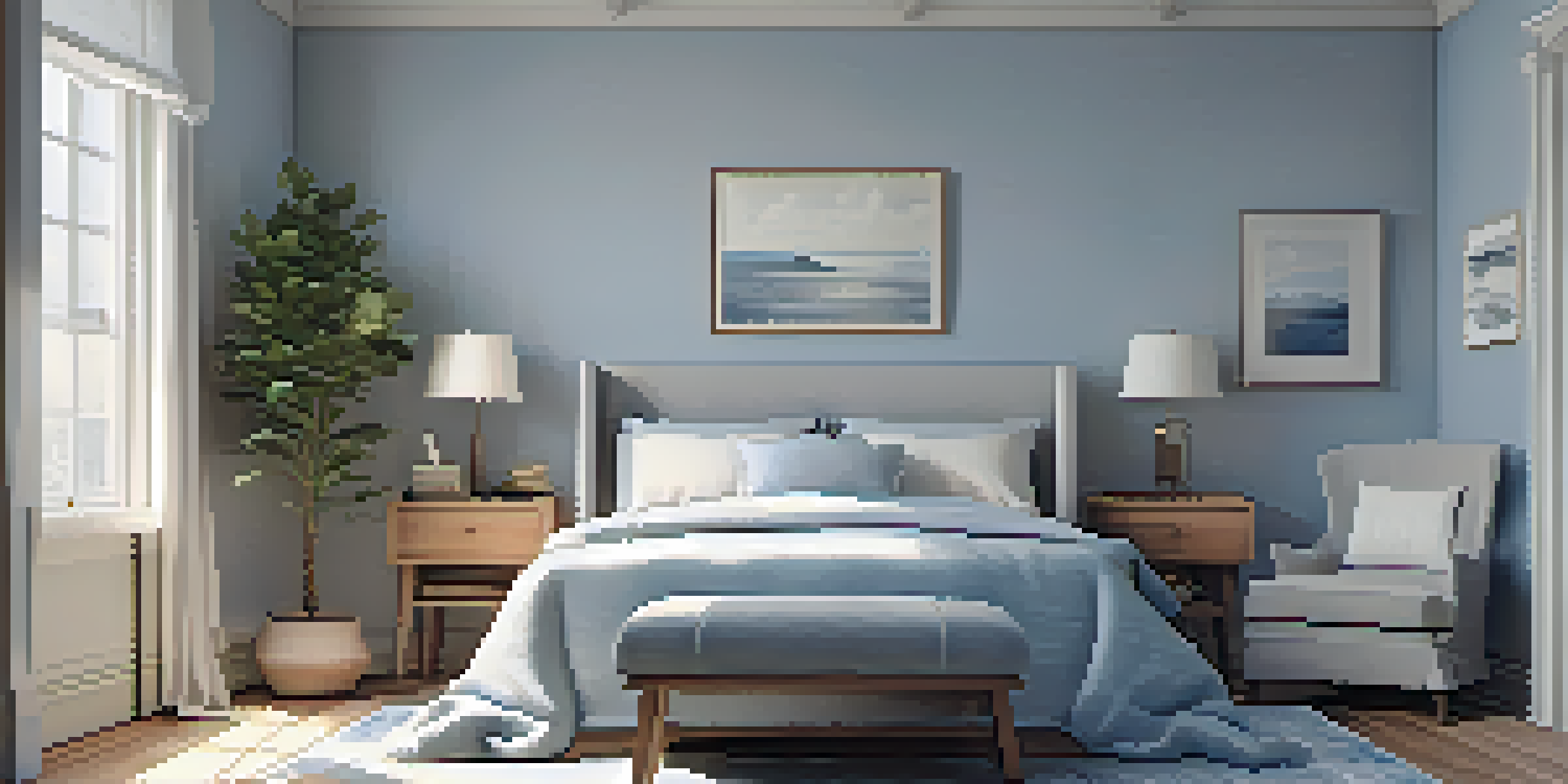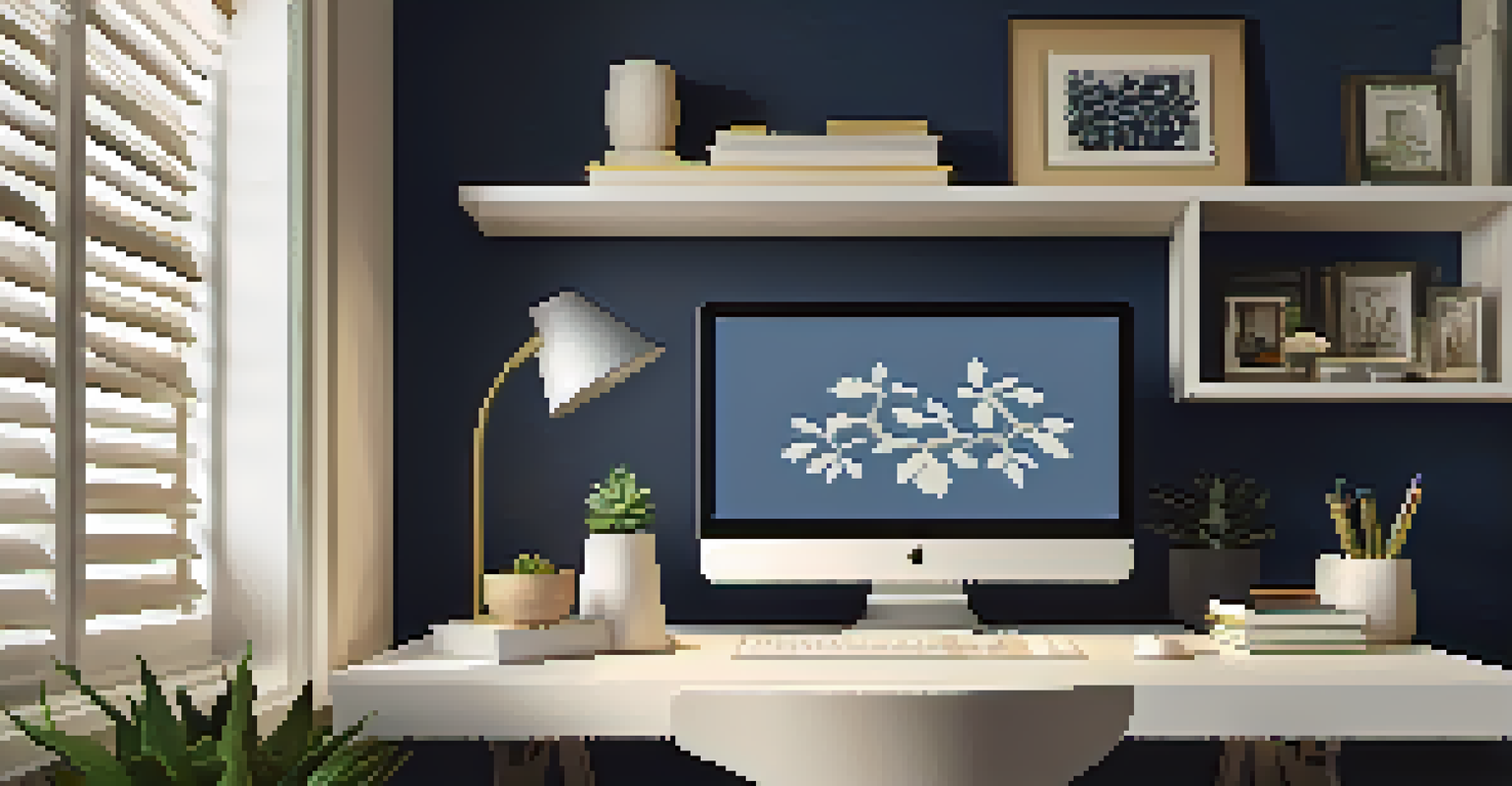The Role of Color in Optimizing Small Living Environments

Understanding Color Psychology in Small Spaces
Color psychology explores how different colors can influence our emotions and behaviors. In small living environments, the right color can create a sense of calm, joy, or energy, affecting how we feel in that space. For example, cool colors like blues and greens tend to promote tranquility, making them ideal for bedrooms or relaxation areas.
Color is the keyboard, the eyes are the harmonies, the soul is the piano with many strings.
Conversely, warm colors such as reds and yellows can evoke feelings of warmth and excitement, potentially making them suitable for dining areas where social interactions take place. By understanding these emotional responses, you can choose colors that align with the purpose of each room, enhancing the overall atmosphere of your small living environment.
Moreover, using color to evoke specific feelings can help you maximize the functionality of a small space. For instance, a small home office painted in calming colors may boost productivity and focus, while a vibrant accent wall can inspire creativity in a compact art studio. Your color choices can significantly impact how effectively you use your living space.
Choosing the Right Colors for Small Rooms
When it comes to selecting colors for small rooms, lighter shades are often recommended. Light colors, such as whites, soft grays, and pastels, can make a room feel more airy and spacious. This is particularly beneficial in smaller environments where you want to avoid a cramped feeling.

On the other hand, darker colors can add depth and richness but might make a small room feel enclosed if overused. However, incorporating darker hues as accents can create a striking contrast without overwhelming the space. For example, a dark blue accent wall with light furniture can strike a perfect balance.
Colors Influence Mood and Functionality
Choosing the right colors can enhance the emotional atmosphere and functionality of small spaces.
Ultimately, the key is to find a balance that works for you. Consider the amount of natural light a room receives and how you want to feel in that space. Testing color samples on the wall can help you visualize how different shades interact with the light throughout the day.
Using Color to Create Visual Illusions
Color can be a powerful tool for creating visual illusions in small living spaces. For instance, painting the ceiling a lighter color than the walls can make the room feel taller. This simple trick draws the eye upward, creating an illusion of height, which can be particularly useful in rooms with low ceilings.
The color of a room can greatly influence the mood and emotions of its inhabitants.
Moreover, using the same color for both walls and trim can create a seamless look that makes the room appear larger. This technique eliminates visual breaks and helps maintain a continuous flow, which is essential in compact spaces. Think of it as creating a canvas that draws the eye around the room.
In addition, strategically placed mirrors can amplify the effects of color and light, further enhancing the illusion of space. By reflecting light and color, mirrors can make even the smallest areas feel more open and inviting, allowing you to maximize your small living environment.
Accent Colors: Adding Personality to Small Spaces
In small living environments, accent colors can be a fun way to add personality without overwhelming the space. Accent colors, which are typically bolder or more vibrant than the primary color scheme, can be introduced through throw pillows, artwork, or decorative items. This approach allows you to express your style while keeping the overall aesthetic cohesive.
Choosing a few key accent colors can create a harmonious look that showcases your personality. For example, if the main color is a soft beige, pops of teal or mustard yellow can add vibrancy without making the room feel chaotic. The key is to choose colors that complement rather than clash with your primary palette.
Light Colors Create Spaciousness
Lighter shades can make small rooms feel more open and airy, while darker hues can add depth if used wisely.
Additionally, you can easily change accent colors with the seasons or your mood, allowing for flexibility in your small space's design. This adaptability means that your living environment can evolve over time, keeping it fresh and exciting without requiring a complete overhaul.
Color Schemes: Finding the Right Balance
Establishing a cohesive color scheme is essential for optimizing small living environments. A well-thought-out color scheme can enhance flow and connectivity between rooms, making the entire space feel larger and more inviting. For small areas, consider using a monochromatic scheme, which involves varying shades of a single color for a sophisticated look.
Alternatively, a complementary color scheme that pairs colors opposite each other on the color wheel can create a dynamic yet balanced feel. For instance, soft blues paired with warm oranges can add interest while remaining visually appealing. This approach can make small spaces feel vibrant and alive, yet harmonious.
When selecting your color scheme, consider the mood you want to create in your living environment. Each color elicits a different emotional response, and harmonizing them effectively can help you achieve your desired atmosphere, whether it be calming, invigorating, or cozy.
The Impact of Light on Color Perception
Lighting plays a crucial role in how we perceive color, especially in small living environments. Natural light can enhance colors, making them appear brighter and more vivid. Therefore, when selecting colors for your space, consider how much natural light each room receives throughout the day.
Artificial lighting also influences color perception. Different types of bulbs can cast varying hues; for instance, warm white bulbs can enhance yellows and reds, while cool white bulbs can make blues and greens pop. Experimenting with different lighting options can help you find the perfect combination that showcases your chosen colors.
Personalization Enhances Connection
Incorporating personal colors and decor allows individuals to create a space that reflects their personality and lifestyle.
Understanding how light interacts with your color selections can help you create the desired ambiance and mood in your small living environment. By considering both natural and artificial lighting, you can optimize your color choices for the best visual impact.
Personalizing Your Space with Color
Ultimately, the best approach to optimizing small living environments with color is to make it personal. Your living space should reflect your personality and lifestyle, so don't hesitate to experiment with colors that resonate with you. This could mean incorporating bold hues that inspire energy or soft pastels that evoke calmness.
Consider creating a mood board with your favorite colors, patterns, and textures to visualize how they come together. This can be a fun way to explore different combinations and see what works best for your space. Remember, there's no right or wrong when it comes to personal expression through color.

Additionally, personal touches like family photos, travel souvenirs, or favorite artworks can enhance the emotional connection to your small living environment. By curating a space that feels authentically you, you'll not only optimize the aesthetics but also create a warm and inviting atmosphere that you love coming home to.